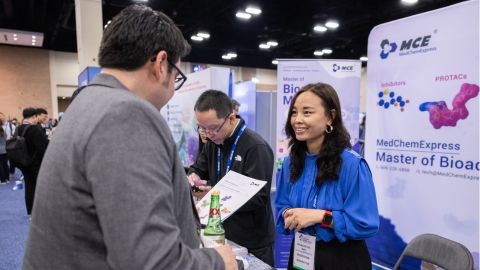
Water is the 2024 molecule of the year
What molecule both splits apart and helps reactions start during photosynthesis?
Water, of course. And out of 54 nominations from the entire spectrum of biochemistry and molecular biology, members of the American Society for Biochemistry and Molecular Biology have cast their votes and elected water as the 2024 molecule of the year.
The nominees, also provided by members, included proteins and protein complexes, RNAs, lipids, drugs and therapeutics, signaling mediators and more.
The winner was nominated by L Andrew Ball, an ASBMB emeritus member and former faculty at the University of Alabama at Birmingham.
“Water is the molecule on which the entire biosphere depends,” Ball wrote in the nomination. “It's the sine qua non of life, and its central role in the future of life — human and otherwise — is gradually becoming recognized.”
Joanna Kotloski, ASBMB’s membership director, created the contest to find out what molecules members thought deserved to be celebrated.
“Part of ASBMB’s mission is to support basic and fundamental research,” Kotloski said. “And there is no molecule more fundamental to the molecular processes of life than water.”
Water's unique properties as a polar molecule enable it to interact with a wide range of substances and facilitate countless biological functions. As a universal solvent, water promotes the proper functioning of enzymes and the transportation of nutrients and waste products within cells.
Water is the foundation of all biochemical processes, providing a conduit for the building blocks of life. In protein folding, water molecules interact with hydrophilic and hydrophobic regions, driving proteins to fold into functional 3D structures. Water is crucial in cellular respiration and photosynthesis and facilitates adenosine triphosphate hydrolysis, which creates cellular energy. In addition, water's ability to hydrogen bond maintains the stability and functionality of nucleic acids, such as DNA and RNA. It carries molecules within and between cells, enabling signal transduction in crucial organs such as the nervous system.
Moreover, water's abundance on Earth is a key reason the planet is teeming with life. The search for water on other planets is a major focus in astrobiology, as the presence of water could indicate potential for life. Without water, life as we know it would cease to exist.
The 2024 molecule of the year will be honored with a collection of essays in ASBMB Today.
Enjoy reading ASBMB Today?
Become a member to receive the print edition four times a year and the digital edition monthly.
Learn moreGet the latest from ASBMB Today
Enter your email address, and we’ll send you a weekly email with recent articles, interviews and more.
Latest in Opinions
Opinions highlights or most popular articles

Embrace your neurodivergence and flourish in college
This guide offers practical advice on setting yourself up for success — learn how to leverage campus resources, work with professors and embrace your strengths.

Survival tools for a neurodivergent brain in academia
Working in academia is hard, and being neurodivergent makes it harder. Here are a few tools that may help, from a Ph.D. student with ADHD.

Hidden strengths of an autistic scientist
Navigating the world of scientific research as an autistic scientist comes with unique challenges —microaggressions, communication hurdles and the constant pressure to conform to social norms, postbaccalaureate student Taylor Stolberg writes.

Black excellence in biotech: Shaping the future of an industry
This Black History Month, we highlight the impact of DEI initiatives, trailblazing scientists and industry leaders working to create a more inclusive and scientific community. Discover how you can be part of the movement.

Attend ASBMB’s career and education fair
Attending the ASBMB career and education fair is a great way to explore new opportunities, make valuable connections and gain insights into potential career paths.

Benefits of attending a large scientific conference
Researchers have a lot of choices when it comes to conferences and symposia. A large conference like the ASBMB Annual Meeting offers myriad opportunities, such as poster sessions, top research talks, social events, workshops, vendor booths and more.

